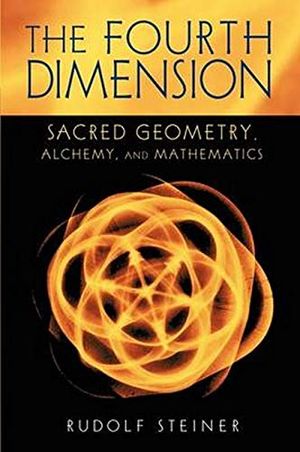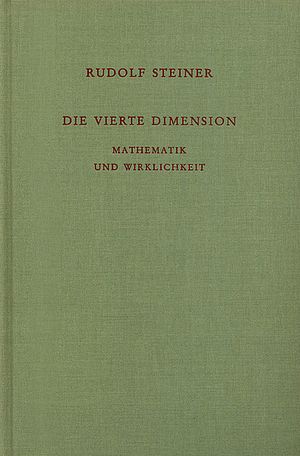GA 324a: Difference between revisions
No edit summary |
No edit summary |
||
| Line 7: | Line 7: | ||
Six connected lectures, Berlin 24 March to 7 June 1905, two individual lectures, Berlin 7 Nov. 1905 and 22 Oct. 1908. Question answers from 1904 to 1922. | Six connected lectures, Berlin 24 March to 7 June 1905, two individual lectures, Berlin 7 Nov. 1905 and 22 Oct. 1908. Question answers from 1904 to 1922. | ||
The point, line, plane and solid objects represent the first three dimensions, but a kind of reversal of space is involved in the ascent to a fourth dimension. Steiner leads us to the brink of this new perspective—as nearly as it can be done with words, diagrams, analogies, and examples of many kinds. In doing so, he continues his lifelong project of demonstrating that our objective, everyday thinking is the lowest rung of a ladder that reaches up to literally infinite heights. The talks in this series and the selections from the question-and-answer sessions on many mathematical topics over the years are translated into English for the first time in The Fourth Dimension. They bring us to tantalizing new horizons of awareness where Steiner hoped to lead his listeners. | |||
The first part of this volume is a series of lectures on the problem of the real existence of a fourth dimension, which was much discussed in the cultural world at the time. A large part of it is devoted to the geometry of four-dimensional bodies. The more extensive second part contains answers to questions on topics such as projective geometry, the speed of light, fluid geometries between the original image and the image, positive and negative numbers, imaginary and super-imaginary numbers, the third Copernican law and, in particular, Albert Einstein's theory of relativity. | The first part of this volume is a series of lectures on the problem of the real existence of a fourth dimension, which was much discussed in the cultural world at the time. A large part of it is devoted to the geometry of four-dimensional bodies. The more extensive second part contains answers to questions on topics such as projective geometry, the speed of light, fluid geometries between the original image and the image, positive and negative numbers, imaginary and super-imaginary numbers, the third Copernican law and, in particular, Albert Einstein's theory of relativity. | ||
Latest revision as of 07:48, 12 September 2021


The Fourth Dimension. Mathematics and Reality
Die vierte Dimension. Mathematik und Wirklichkeit
Listener's notes from lectures on multi-dimensional space and from question answers on mathematical topics.
Six connected lectures, Berlin 24 March to 7 June 1905, two individual lectures, Berlin 7 Nov. 1905 and 22 Oct. 1908. Question answers from 1904 to 1922.
The point, line, plane and solid objects represent the first three dimensions, but a kind of reversal of space is involved in the ascent to a fourth dimension. Steiner leads us to the brink of this new perspective—as nearly as it can be done with words, diagrams, analogies, and examples of many kinds. In doing so, he continues his lifelong project of demonstrating that our objective, everyday thinking is the lowest rung of a ladder that reaches up to literally infinite heights. The talks in this series and the selections from the question-and-answer sessions on many mathematical topics over the years are translated into English for the first time in The Fourth Dimension. They bring us to tantalizing new horizons of awareness where Steiner hoped to lead his listeners.
The first part of this volume is a series of lectures on the problem of the real existence of a fourth dimension, which was much discussed in the cultural world at the time. A large part of it is devoted to the geometry of four-dimensional bodies. The more extensive second part contains answers to questions on topics such as projective geometry, the speed of light, fluid geometries between the original image and the image, positive and negative numbers, imaginary and super-imaginary numbers, the third Copernican law and, in particular, Albert Einstein's theory of relativity.
Literature
- Rudolf Steiner, C. E. Creeger (Translator): The Fourth Dimension: Sacred Geometry, Alchemy and Mathematics: Sacred Geometry, Alchemy, and Mathematics. CW 324a. Anthroposophic Press 2001. ISBN 978-0880104722; eBook ASIN B006VIMNB4 rsarchive.org
German
- Rudolf Steiner: Die vierte Dimension, GA 324a (1995), ISBN 3-7274-3245-4 English: rsarchive.org German: pdf pdf(2) html mobi epub archive.org
 |
References to the work of Rudolf Steiner follow Rudolf Steiner's Collected Works (CW or GA), Rudolf Steiner Verlag, Dornach/Switzerland, unless otherwise stated.
Email: verlag@steinerverlag.com URL: www.steinerverlag.com. Index to the Complete Works of Rudolf Steiner - Aelzina Books A complete list by Volume Number and a full list of known English translations you may also find at Rudolf Steiner's Collected Works Rudolf Steiner Archive - The largest online collection of Rudolf Steiner's books, lectures and articles in English. Rudolf Steiner Audio - Recorded and Read by Dale Brunsvold steinerbooks.org - Anthroposophic Press Inc. (USA) Rudolf Steiner Handbook - Christian Karl's proven standard work for orientation in Rudolf Steiner's Collected Works for free download as PDF. |
